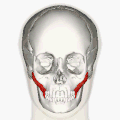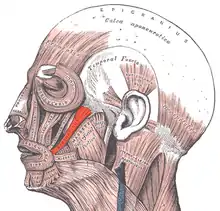Zygomaticus major muscle
The zygomaticus major muscle is a muscle of the human body. It extends from each zygomatic arch (cheekbone) to the corners of the mouth. It is a muscle of facial expression which draws the angle of the mouth superiorly and posteriorly to allow one to smile. Bifid zygomaticus major muscle is a notable variant, and may cause cheek dimples.
| Zygomaticus major | |
|---|---|
 Muscles of the head, face, and neck. Zygomaticus major shown in red. | |
| Details | |
| Origin | anterior of zygomatic |
| Insertion | modiolus of the mouth |
| Artery | facial artery |
| Nerve | zygomatic and buccal branches of the facial nerve |
| Actions | draws the angle of the mouth upward laterally |
| Identifiers | |
| Latin | musculus zygomaticus major |
| TA98 | A04.1.03.029 |
| TA2 | 2079 |
| FMA | 46810 |
| Anatomical terms of muscle | |
Structure
The zygomaticus major muscle originates from the upper margin of the temporal process, part of the lateral surface of the zygomatic bone.[1][2] It inserts into tissue at the corner of the mouth.[2]
Nerve supply
The zygomaticus major muscle is supplied by a buccal branch and a zygomatic branch of the facial nerve (VII).
Variation
The zygomaticus major muscle may occur in a bifid form, with two fascicles that are partially or completely separate from each other but adjacent.[1][3] Usually a single unit, dimples are caused by variations in form.[4][5] It is thought that cheek dimples are caused by bifid zygomaticus major muscle.[3]
Function
The zygomaticus major muscle raises the corners of the mouth and draws them posteriorly when a person smiles.[6] The average muscle can contract with a force of 200 g.[2]
Clinical significance
The zygomaticus major muscle may be used in reconstructive surgery to replace lost tissue, such as with injuries to the lips.[7]
Image
 Position of zygomaticus major muscle. Animation.
Position of zygomaticus major muscle. Animation. Muscles of the head, face, and neck. Zygomaticus major shown in red.
Muscles of the head, face, and neck. Zygomaticus major shown in red.
See also
References
- "Zygomaticus major muscle bony attachment site: a Thiel-embalmed cadaver study". Morphologie. 105 (348): 24–28. 2021-02-01. doi:10.1016/j.morpho.2020.06.009. ISSN 1286-0115.
- Kim, Kyoung-Eun; Oh, Seung Ha; Lee, Shi-Uk; Chung, Sun G. (2009-10-01). "Application of isometric load on a facial muscle – The zygomaticus major". Clinical Biomechanics. 24 (8): 606–612. doi:10.1016/j.clinbiomech.2009.06.008. ISSN 0268-0033 – via ScienceDirect.
- Pessa, Joel E.; Zadoo, Vikram P.; Garza, Peter A.; Adrian, Erle K.; Dewitt, Adriane I.; Garza, Jaime R. (1998). "Double or bifid zygomaticus major muscle: Anatomy, incidence, and clinical correlation". Clinical Anatomy. 11 (5): 310–313. doi:10.1002/(SICI)1098-2353(1998)11:5<310::AID-CA3>3.0.CO;2-T. PMID 9725574.
- "Dimple Creation – Cute as a button, who pays for a deformity?".
- "Zygomaticus Major Muscle Function, Origin & Anatomy".
- Stel, Mariëlle; van Dijk, Eric; Olivier, Einav (2009). "You Want to Know the Truth? Then Don't Mimic!". Psychological Science. 20 (6): 694. doi:10.1111/j.1467-9280.2009.02350.x. PMID 19422628.
- Lidhar, T.; Sharma, S.; Ethunandan, M. (2021-01-01). "Split zygomaticus major muscle sling reconstruction for significant lower lip defects". British Journal of Oral and Maxillofacial Surgery. 59 (1): 106–108. doi:10.1016/j.bjoms.2020.06.031. ISSN 0266-4356 – via ScienceDirect.